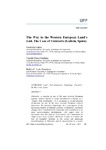The Way to the Western European Land’s End. The Case of Finisterre (Galicia, Spain)

Ver/
Use este enlace para citar
http://hdl.handle.net/2183/38997Coleccións
- Investigación (FEDU) [939]
Metadatos
Mostrar o rexistro completo do ítemTítulo
The Way to the Western European Land’s End. The Case of Finisterre (Galicia, Spain)Data
2017Cita bibliográfica
Lopez, L., Pérez-Guilarte, Y., & Lois-González, R. C. (2017). The Way to the Western European Land’s End. The Case of Finisterre (Galicia, Spain). Italian Journal of Planning Practice, 7(1), 186–212.
Resumo
[Abstract] Finisterre, a location at one of the most western European regions: Galicia (Spain) is being repositioned in Europe as a “Land’s End destination”. It is becoming a second possible destination for one of the most relevant European cultural itineraries: the Jacobean Pilgrimage. As a consequence of the increasing number of pilgrims arriving at Finisterre, territorial changes have transformed the landscape and contributed to its local socio-economic development. This paper aims to investigate how this kind of “reinvention” has contributed to shape a new sense of place. Moreover, it aims to evaluate the role of intangible heritage in the social and landscape transformations in Finisterre and its reconversion to a tourist destination. We will address the changes occurred in the tourist offer over an 18 years period, including pilgrims’ hostels and reception facilities; the institutional tourist promotion; and pilgrims’ profile and behaviour. The research methodology is based on the use of statistical sources and document archives from the Pilgrim’s Office. It also presents an empirical study through the application of questionnaires to managers of local accommodation facilities and a semi-structured interview to the director of the Tourist Office of Finisterre. The results contribute to highlight the changes that are taking place in Finisterre, both in terms of its peripheral condition, and in regards to the level of tourism management.
Palabras chave
Land’s end destination
Pilgrimage
Finisterre
Way of Saint James
Pilgrimage
Finisterre
Way of Saint James
Dereitos
CC0 1.0 Universal
ISSN
2239-267X






